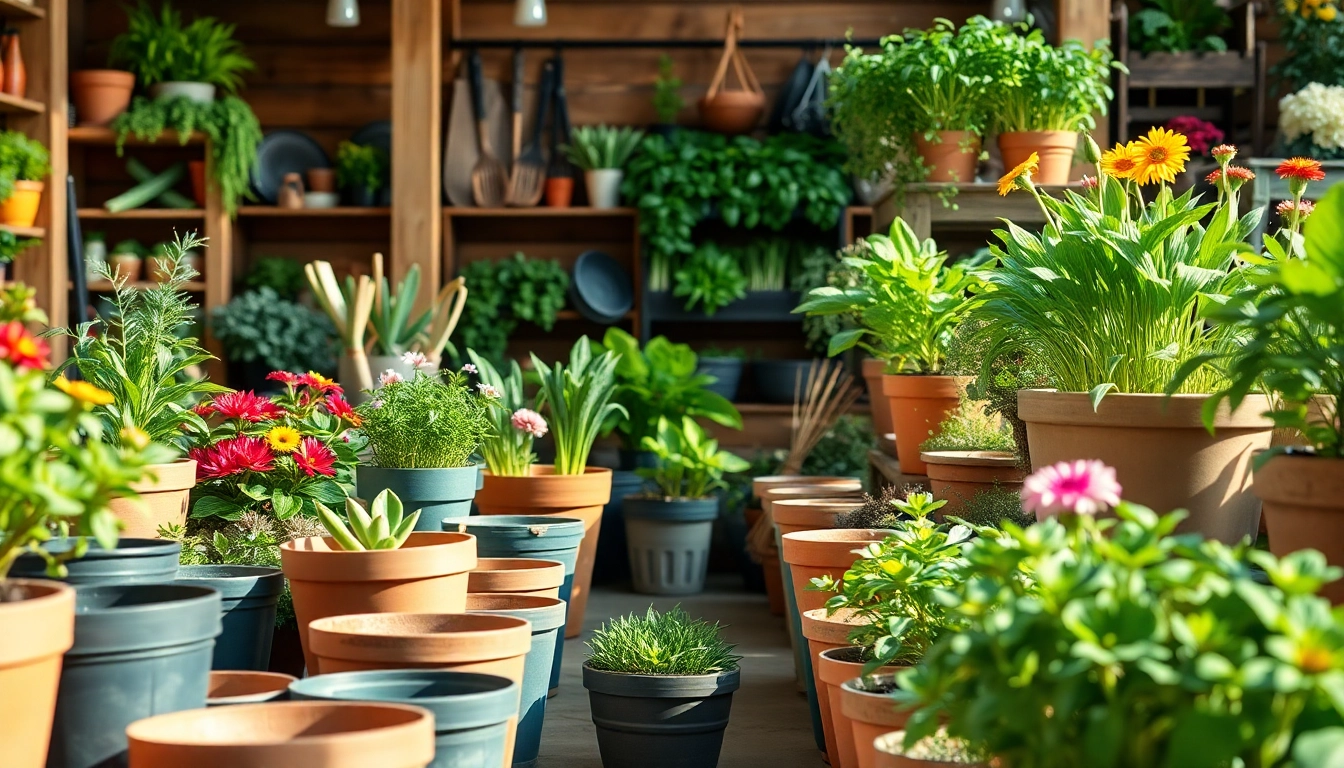Understanding the Basics of a Grow A Garden Shop
What is a Grow A Garden Shop?
A Grow A Garden Shop is a retail space specializing in gardening supplies, plants, pots, seeds, and all the essentials required to cultivate a vibrant garden. Whether you are catering to seasoned gardeners or newcomers eager to start their green journey, the shop serves as a resource hub for gardening enthusiasts. It can encompass everything from rare plants and unique garden decor to offering seeds for popular vegetables and flowers. In recent years, the concept has adapted to online formats as well, allowing shop owners to reach a broader audience through e-commerce platforms.
Key Products to Offer in Your Garden Shop
When establishing a grow a garden shop, it’s essential to curate a selection of products that meet the diverse needs of gardeners. Here are several key categories to consider:
- Plants: A vibrant collection of indoor and outdoor plants, including flowers, herbs, and vegetables, will appeal to a wide customer base.
- Seeds: Offering seeds from renowned brands, including organic and heirloom varieties, helps cater to various planting preferences.
- Soils and Fertilizers: Quality soil products and organic fertilizers are fundamental to encouraging healthy plant growth.
- Gardening Tools: Providing high-quality tools such as shovels, pruners, and watering cans enhances customer experience.
- Pots and Planters: A selection of attractive planters and pots in different sizes is crucial, accommodating both indoor and outdoor gardening.
- Garden Accessories: Items such as plant supports, trellises, and decorative stones can enrich the gardening experience for customers.
Target Audience for Gardening Supplies
Understanding the target audience is critical for any business. A garden shop’s customer base can vary widely but generally includes the following groups:
- Avid Gardeners: Individuals with extensive gardening knowledge seeking specialized plants and tools.
- New Gardeners: Beginners who need guidance on what to buy and how to cultivate their gardens effectively.
- DIY Enthusiasts: People looking to enhance their homes with plants, often interested in unique or trendy items.
- Eco-Conscious Consumers: Customers prioritizing organic and sustainable gardening practices.
Creating Your Business Plan
Identifying Your Niche in the Market
In the competitive market of gardening supplies, identifying a niche can set your grow a garden shop apart from competitors. Consider factors such as:
- Specialty Plants: Focus on rare or unique plants that aren’t readily available in big-box stores.
- Organic Products: Offer a range of organic gardening inputs that appeal to health and environmentally conscious consumers.
- Online Sales: Enhance your reach by developing an e-commerce platform alongside your physical store, offering convenient shopping options.
- Educational Workshops: Position your business as a knowledge hub by hosting workshops aimed at educating customers on gardening techniques.
Cost Analysis and Budgeting for Your Shop
The financial foundation of your grow a garden shop is critical for success. Conduct a thorough cost analysis and budgeting process that includes:
- Startup Costs: Estimate expenses for inventory, a physical location (if applicable), marketing, and staffing.
- Operational Expenses: Account for recurring costs such as rent, utilities, payroll, and maintenance.
- Marketing Budget: Allocate funds for promotional activities to attract customers, both online and offline.
Setting Up Your Location and Store Layout
The physical layout of your grow a garden shop can significantly influence the shopping experience. Consider the following when designing your store:
- Welcoming Ambiance: Use natural light, soft color palettes, and convenient navigation to create an inviting atmosphere.
- Logical Product Placement: Organize products in a way that makes sense to shoppers; seasonal displays can boost interest and sales.
- Interactive Spaces: Create an area for demonstrations, workshops, or a small cafe to encourage customers to linger.
Marketing Strategies to Promote Your Grow A Garden Shop
Leveraging Social Media for Engagement
In today’s digital age, social media is a powerful tool that can significantly enhance your garden shop’s visibility. Here are effective strategies:
- Content Creation: Post engaging content that resonates with gardening enthusiasts, including tips, planting advice, and customer spotlights.
- Visual Appeal: Share beautiful images of plants in your shop, gardening projects, or customer testimonials to attract attention.
- Live Sessions: Host Q&A sessions or tutorials via live streams to foster a connection with your audience.
Building a Local Community Presence
Establishing a presence in your local community can create loyal customers. Strategies include:
- Community Events: Participate in local fairs, farmers markets, or gardening expos to showcase your offerings.
- Partnerships: Collaborate with local schools, garden clubs, or environmental organizations to create mutual benefits.
- Promotions: Offer incentives such as discounts for local residents or loyalty programs to encourage repeat visits.
Utilizing SEO to Drive Online Traffic
Search Engine Optimization (SEO) can help increase the online visibility of your garden shop. Focus on:
- Keyword Research: Identify relevant keywords associated with gardening, such as “organic gardening supplies” or “rare plants.”
- On-site Optimization: Optimize your website’s content, meta tags, and images to improve search rankings.
- Content Marketing: Create a blog centered around gardening tips and trends that encourages organic traffic.
Managing Inventory and Supplier Relationships
Selecting Trusted Suppliers for Quality Products
Your relationship with suppliers is critical, affecting product quality and customer satisfaction. Focus on:
- Reputable Vendors: Research and build relationships with established suppliers offering high-quality products.
- Product Diversity: Ensure suppliers offer a wide range of products to cater to varying customer needs.
- Negotiating Terms: Establish favorable terms and conditions that benefit both parties and ensure timely product delivery.
Effective Inventory Management Techniques
Managing inventory efficiently can prevent overstocking or stockouts, which can harm sales. Consider these techniques:
- Regular Audits: Conduct frequent audits to assess inventory levels and sales trends.
- Automated Systems: Utilize inventory management software for real-time tracking and analysis.
- Seasonal Adjustments: Adjust inventory based on seasonal demands to ensure your shop has the right products year-round.
Pricing Strategies for Competitive Advantage
Determining the right pricing strategy can enhance sales while remaining competitive. Consider these approaches:
- Market Research: Analyze competitor pricing to ensure your prices are within an acceptable range.
- Value-based Pricing: Set prices based on the perceived value of your products rather than solely on cost.
- Discount Strategies: Implement promotion strategies such as seasonal sales or bundle discounts.
Evaluating Your Grow A Garden Shop Performance
Key Performance Indicators to Track
Assessing the performance of your garden shop is essential for making informed decisions. Key performance indicators (KPIs) to monitor include:
- Sales Growth: Measurement of revenue growth over time helps gauge business expansion.
- Customer Acquisition Cost: Understand the cost associated with attracting new customers to your shop.
- Inventory Turnover Rate: Knowing how quickly inventory sells can help refine purchasing decisions.
Feedback and Improvement Strategies
Gathering feedback from customers is crucial for continuous improvement. Implement strategies such as:
- Surveys: Conduct customer satisfaction surveys to gain insight into areas for improvement.
- Online Reviews: Encourage customers to leave reviews to build credibility and trust.
- In-store Feedback: Create a suggestion box in your shop to gather feedback from patrons directly.
Long-term Growth Strategies for Sustainability
For ongoing success, consider these long-term strategies:
- Diversification: Expand product lines to include organic pest control solutions or garden decor.
- Franchise Opportunities: If successful, consider franchising your model to other regions.
- Invest in Technology: Incorporate e-commerce and mobile solutions to reach a broader audience and streamline operations.











Leave a Reply